-
Early Bond Designs
Featured Bond: 1780—Virginia Land-Office Treasury Warrant
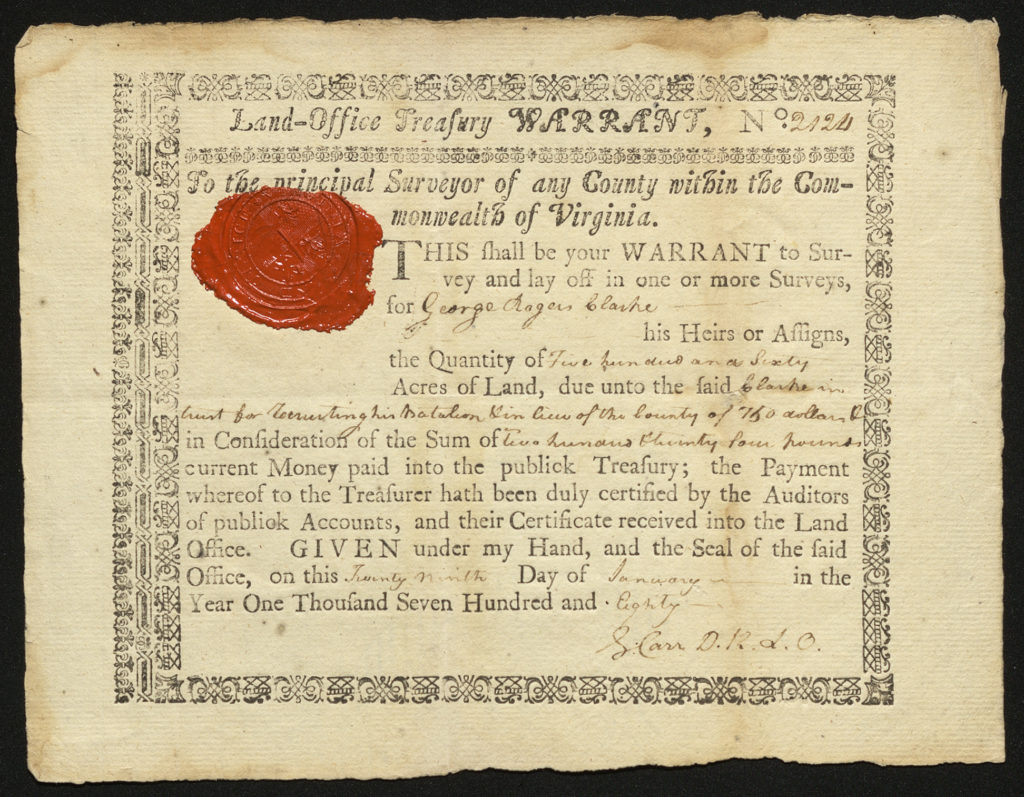
-
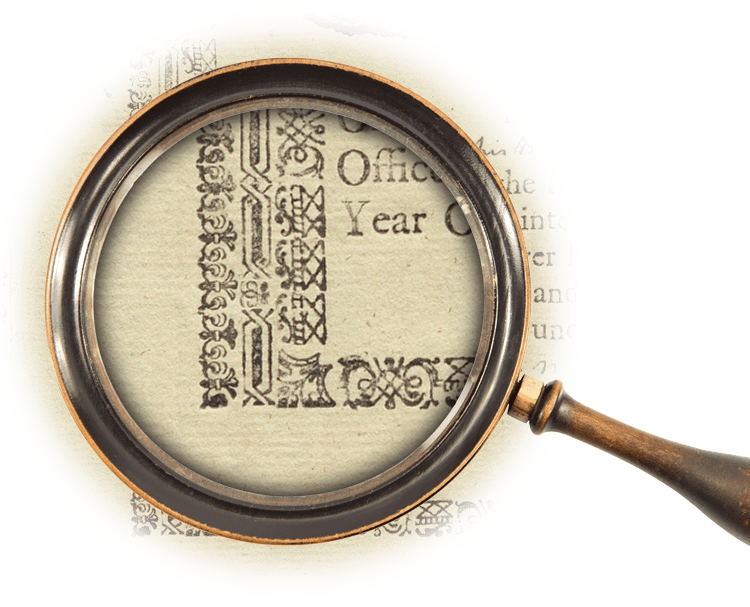 1. As the oldest document in this collection, this Land-Office Treasury Warrant has some of the simplest design. This decorative border has nowhere near the level of complexity found in later designs.
1. As the oldest document in this collection, this Land-Office Treasury Warrant has some of the simplest design. This decorative border has nowhere near the level of complexity found in later designs. -
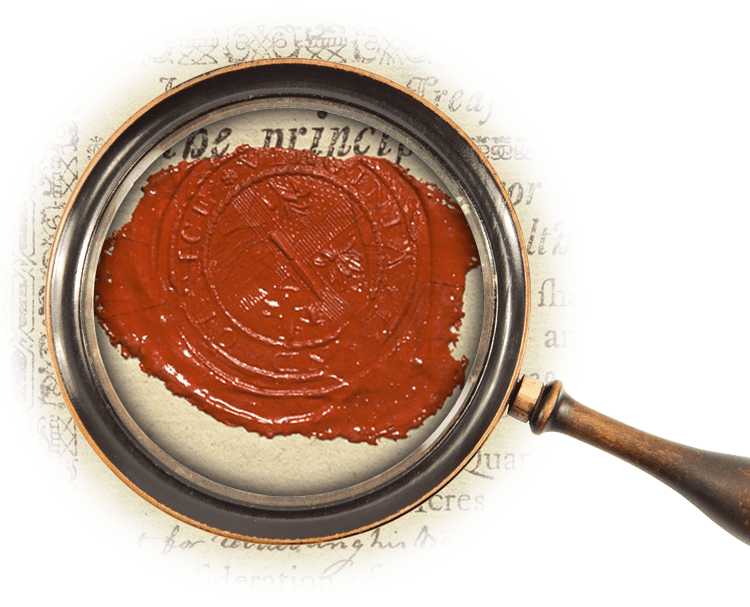 2. This red wax stamp shows the seal of the Virginia Land-Office, showing that this bond was issued by a legitimate agency and serving as an anti-counterfeiting measure.
2. This red wax stamp shows the seal of the Virginia Land-Office, showing that this bond was issued by a legitimate agency and serving as an anti-counterfeiting measure. -
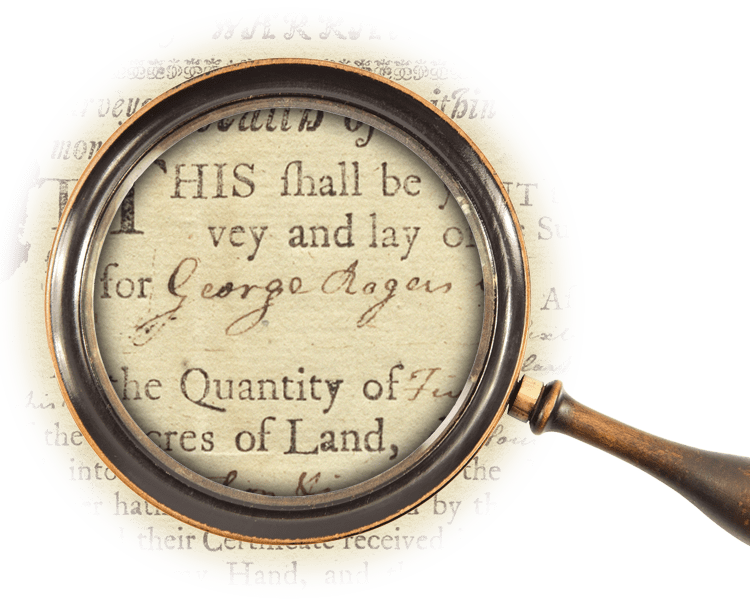 3. The owner of this warrant, George Rogers Clark (signed here as ‘Clarke’), was a hero of the Revolutionary War known for recruiting and leading a battalion of men in the Battle of Vincennes.
3. The owner of this warrant, George Rogers Clark (signed here as ‘Clarke’), was a hero of the Revolutionary War known for recruiting and leading a battalion of men in the Battle of Vincennes. -
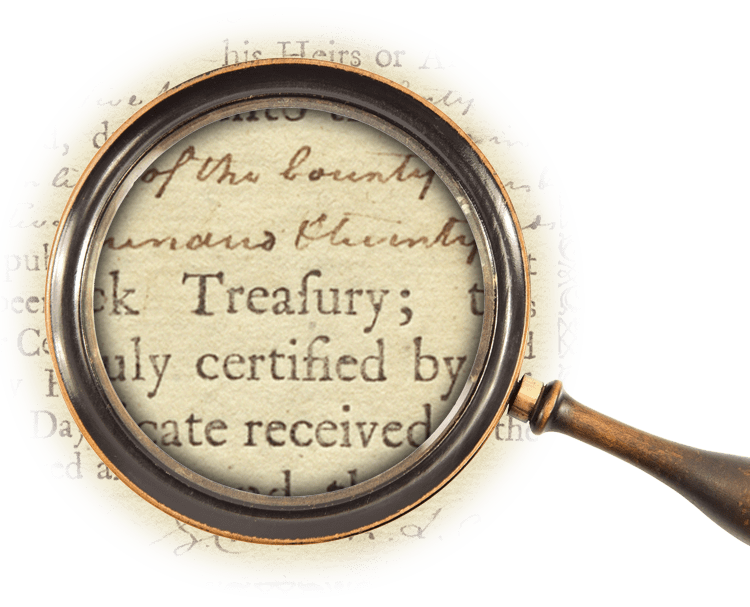 4. This document is old enough that the lower-case ‘s’ is written as an ‘f’ although this practice fell out of use by the early nineteenth century.
4. This document is old enough that the lower-case ‘s’ is written as an ‘f’ although this practice fell out of use by the early nineteenth century.
-
-
Early Vignettes
Featured Bond: 1796—Philadelphia and Lancaster Turnpike Company
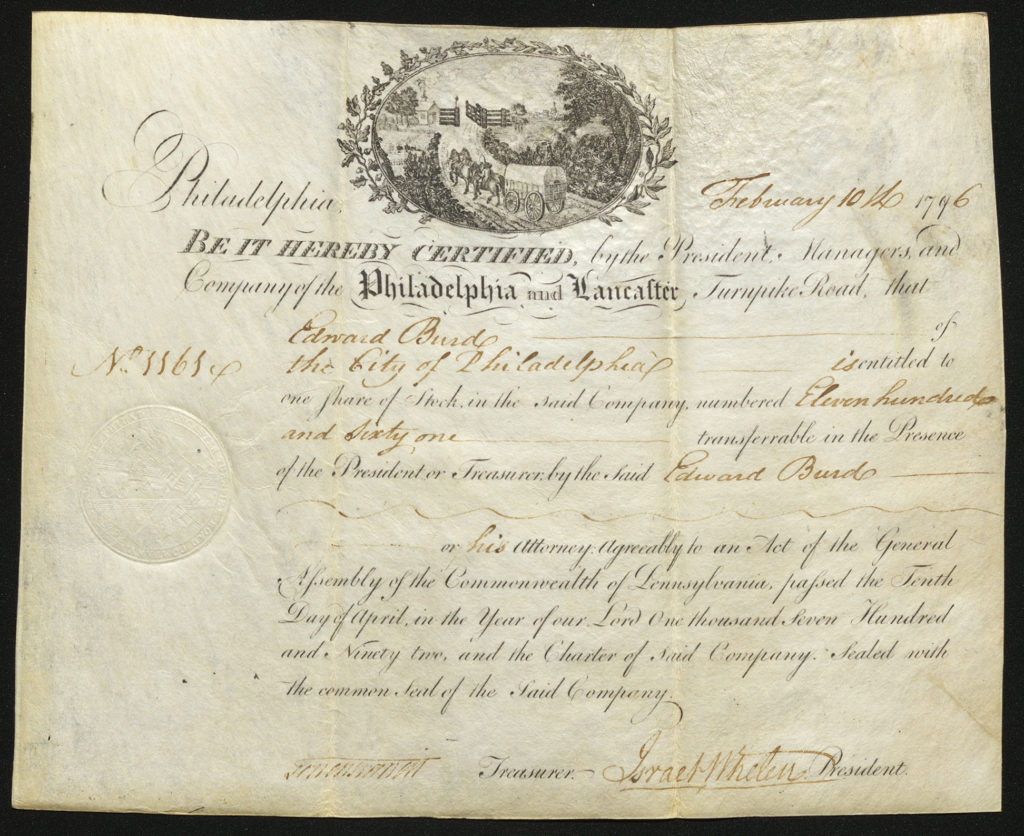
-
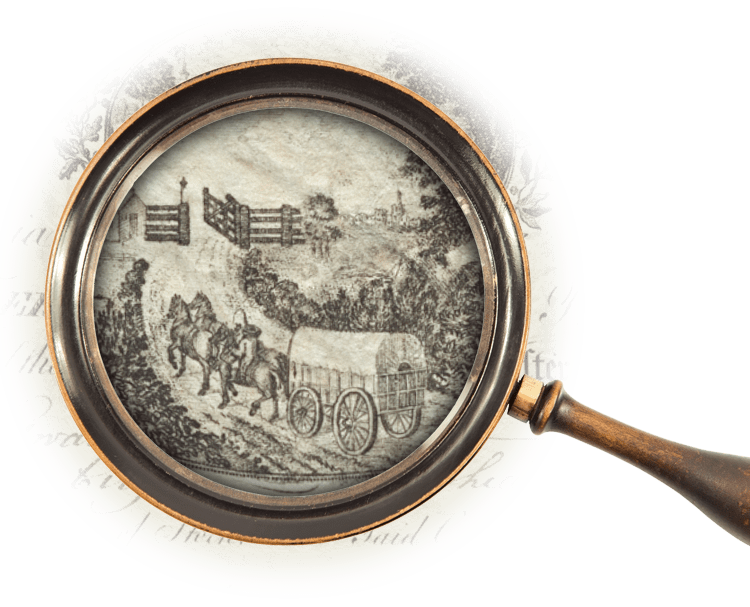 1. The pictures shown on bonds are referred to as 'vignettes' and illustrate a company’s business to show the certificate holder his or her investment. This certificate is one of the earliest bond designs known to have been printed with a vignette—previously, the documents just had written descriptions—making it highly valuable.
1. The pictures shown on bonds are referred to as 'vignettes' and illustrate a company’s business to show the certificate holder his or her investment. This certificate is one of the earliest bond designs known to have been printed with a vignette—previously, the documents just had written descriptions—making it highly valuable. -
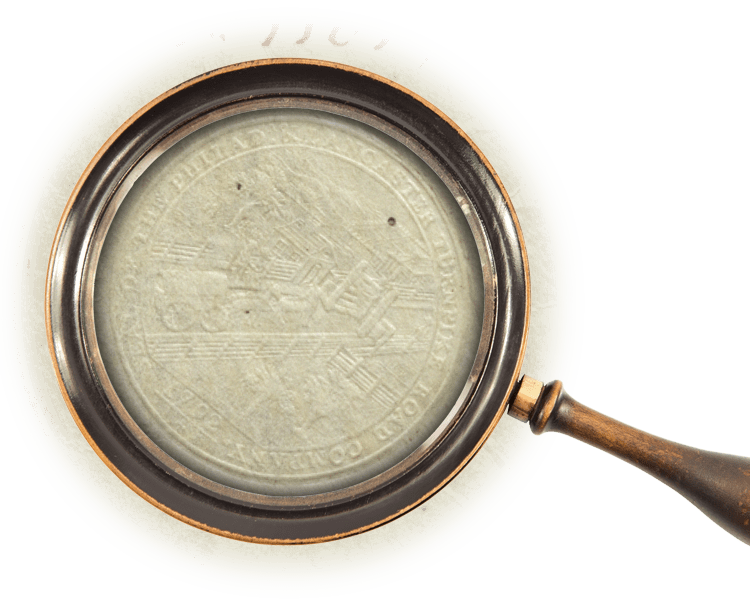 2. A faint embossed logo similar to the vignette, shows a wagon approaching a toll gate from a different perspective, ringed by the company name. Like the earlier wax seal technique, this unique three-dimensional stamp shows that this is a legitimate bond distributed by the company and serves as an anti-counterfeiting measure.
2. A faint embossed logo similar to the vignette, shows a wagon approaching a toll gate from a different perspective, ringed by the company name. Like the earlier wax seal technique, this unique three-dimensional stamp shows that this is a legitimate bond distributed by the company and serves as an anti-counterfeiting measure. -
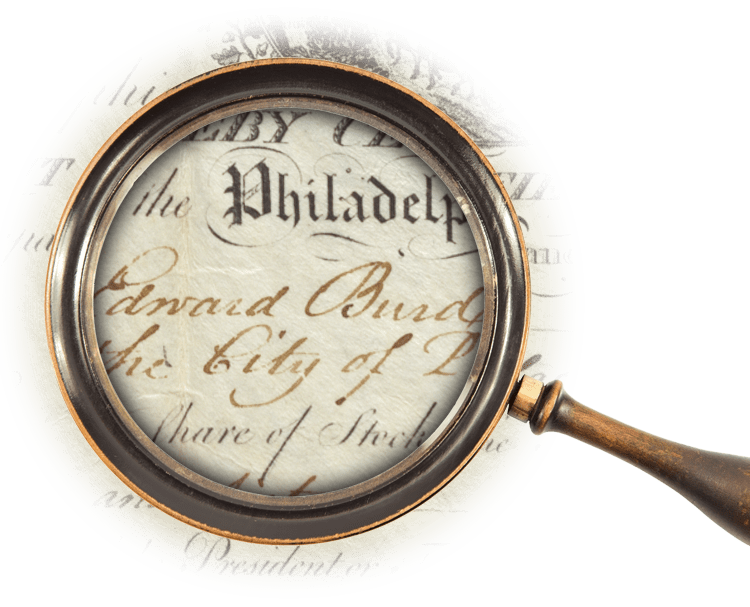 3. This certificate was originally owned by Edward Burd, who served as a Major in the American Revolution. On the back side of the document, there is a list of transfers as the bond was sold several times. At one point it was owned by Thomas Biddle who was a hero of the War of 1812 and was later killed in a duel.
3. This certificate was originally owned by Edward Burd, who served as a Major in the American Revolution. On the back side of the document, there is a list of transfers as the bond was sold several times. At one point it was owned by Thomas Biddle who was a hero of the War of 1812 and was later killed in a duel. -
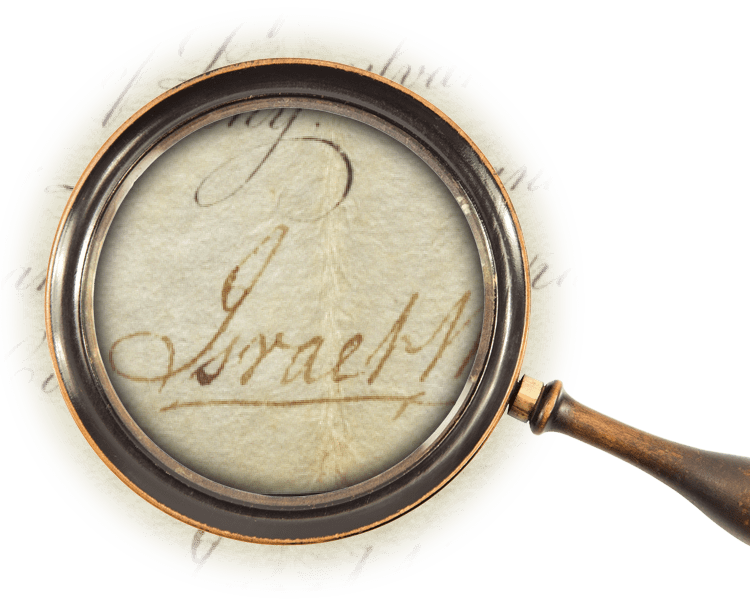 4. Bonds were generally endorsed by leaders of the company or political institution. This bond is signed by company president Israel Whelen. Whelen served as a Captain and financial agent during the Revolutionary War and later became director of the First Bank of the United States.
4. Bonds were generally endorsed by leaders of the company or political institution. This bond is signed by company president Israel Whelen. Whelen served as a Captain and financial agent during the Revolutionary War and later became director of the First Bank of the United States.
-
-
Vignettes Evolve with Detail and Symbolism
Featured Bond: 1856—Baltimore and Ohio Railroad Company
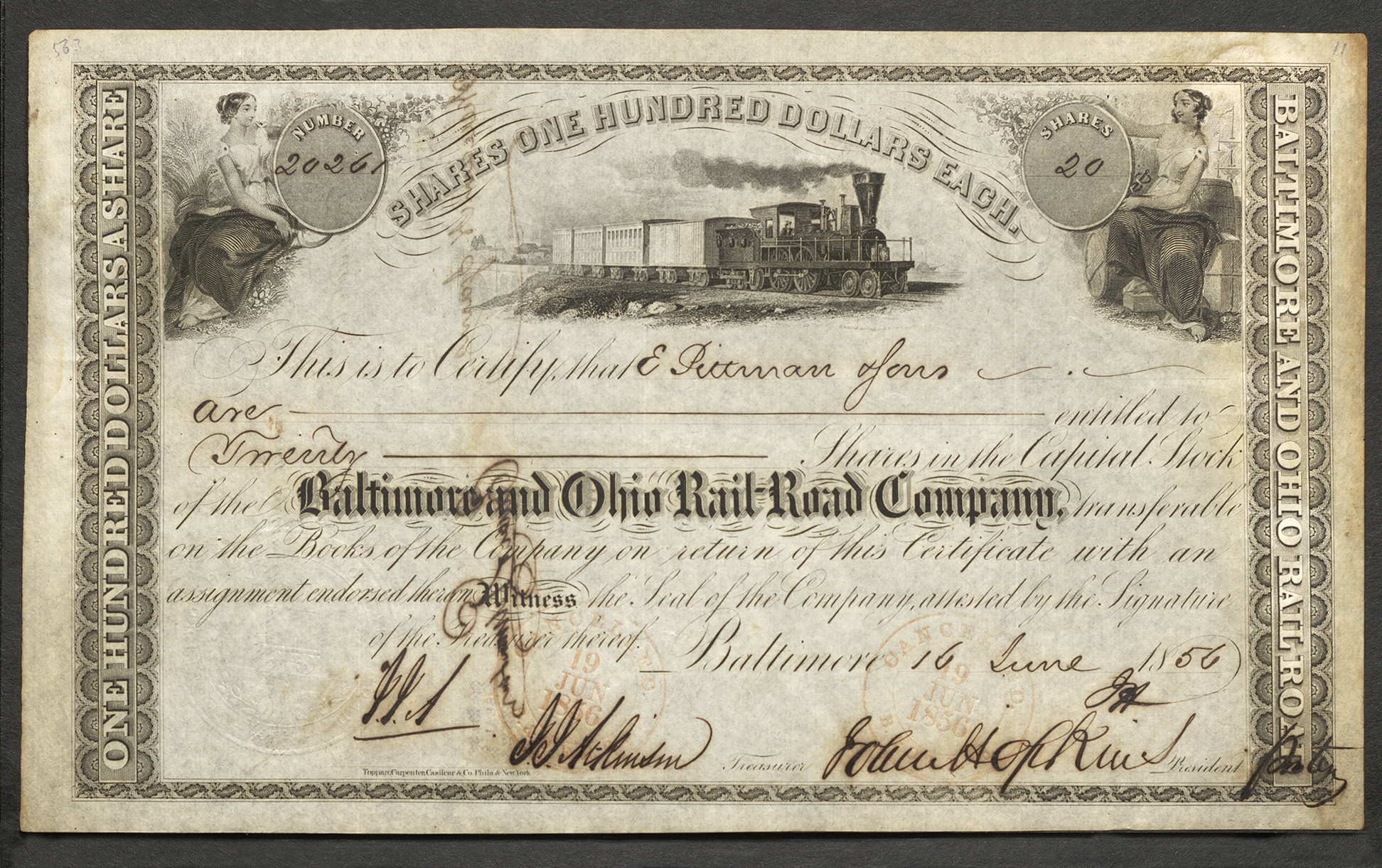
-
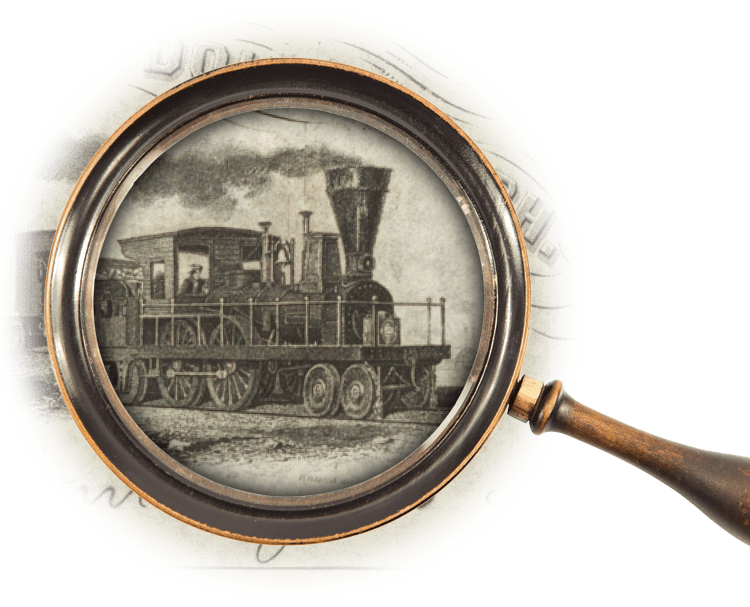 1. Early vignettes tended to be literal in their representations, such as depicting a locomotive for a railroad company as seen here. This certificate shows vignette additions of allegorical image. Notice the beautiful women representing goddesses in the upper corners.
1. Early vignettes tended to be literal in their representations, such as depicting a locomotive for a railroad company as seen here. This certificate shows vignette additions of allegorical image. Notice the beautiful women representing goddesses in the upper corners. -
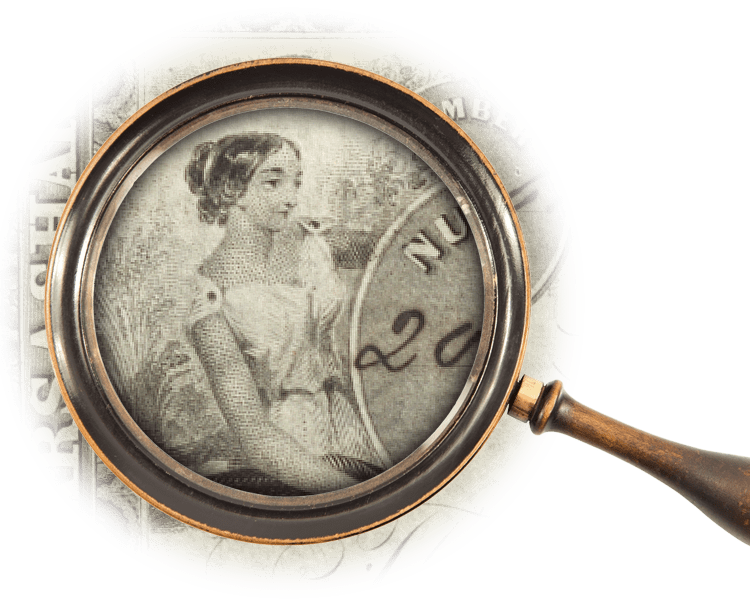 2. In the left corner a maiden representing the Roman goddess of agriculture Ceres holds a sickle while surrounded by wheat and grape vines.
2. In the left corner a maiden representing the Roman goddess of agriculture Ceres holds a sickle while surrounded by wheat and grape vines. -
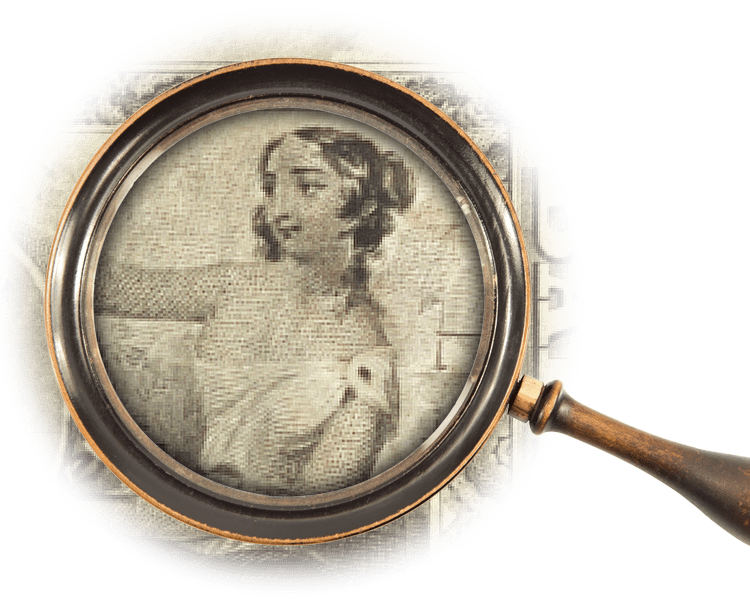 3. In the right, another maiden representing the Greek goddess Athena sits on a pile of cargo at (presumably) the port of Baltimore, with the sails of a ship visible in the background. In her hand is a caduceus representing Hermes, messenger of the gods, in this context alluding to commerce and trade.
3. In the right, another maiden representing the Greek goddess Athena sits on a pile of cargo at (presumably) the port of Baltimore, with the sails of a ship visible in the background. In her hand is a caduceus representing Hermes, messenger of the gods, in this context alluding to commerce and trade. -
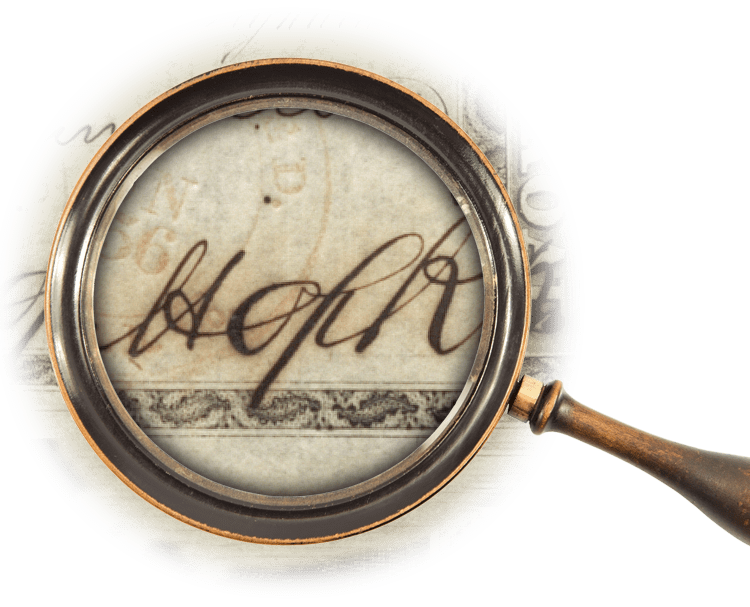 4. Johns Hopkins signed this bond as president of the railroad company. Hopkins was a self-made entrepreneur and philanthropist, endowing millions of dollars to found the Johns Hopkins Hospital and University in the 1860s–1870s.
4. Johns Hopkins signed this bond as president of the railroad company. Hopkins was a self-made entrepreneur and philanthropist, endowing millions of dollars to found the Johns Hopkins Hospital and University in the 1860s–1870s. -
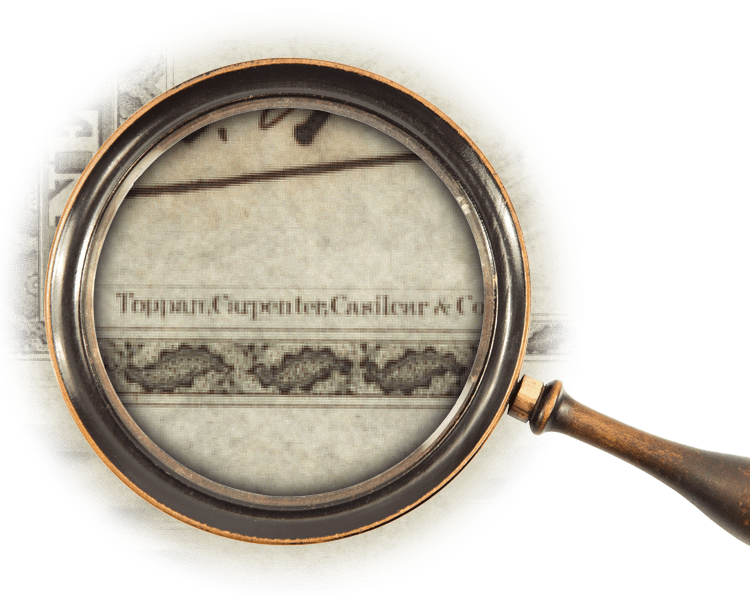 5. This certificate was printed by Toppan, Carpenter, Casilear & Co. who also printed U.S. postage (1851–1861) and later became the American Bank Note Company, one of the four most prolific producers of stock and bond certificates at the time.
5. This certificate was printed by Toppan, Carpenter, Casilear & Co. who also printed U.S. postage (1851–1861) and later became the American Bank Note Company, one of the four most prolific producers of stock and bond certificates at the time.
-
-
Early Company Logos
Featured Bond: 1863—American Express Company
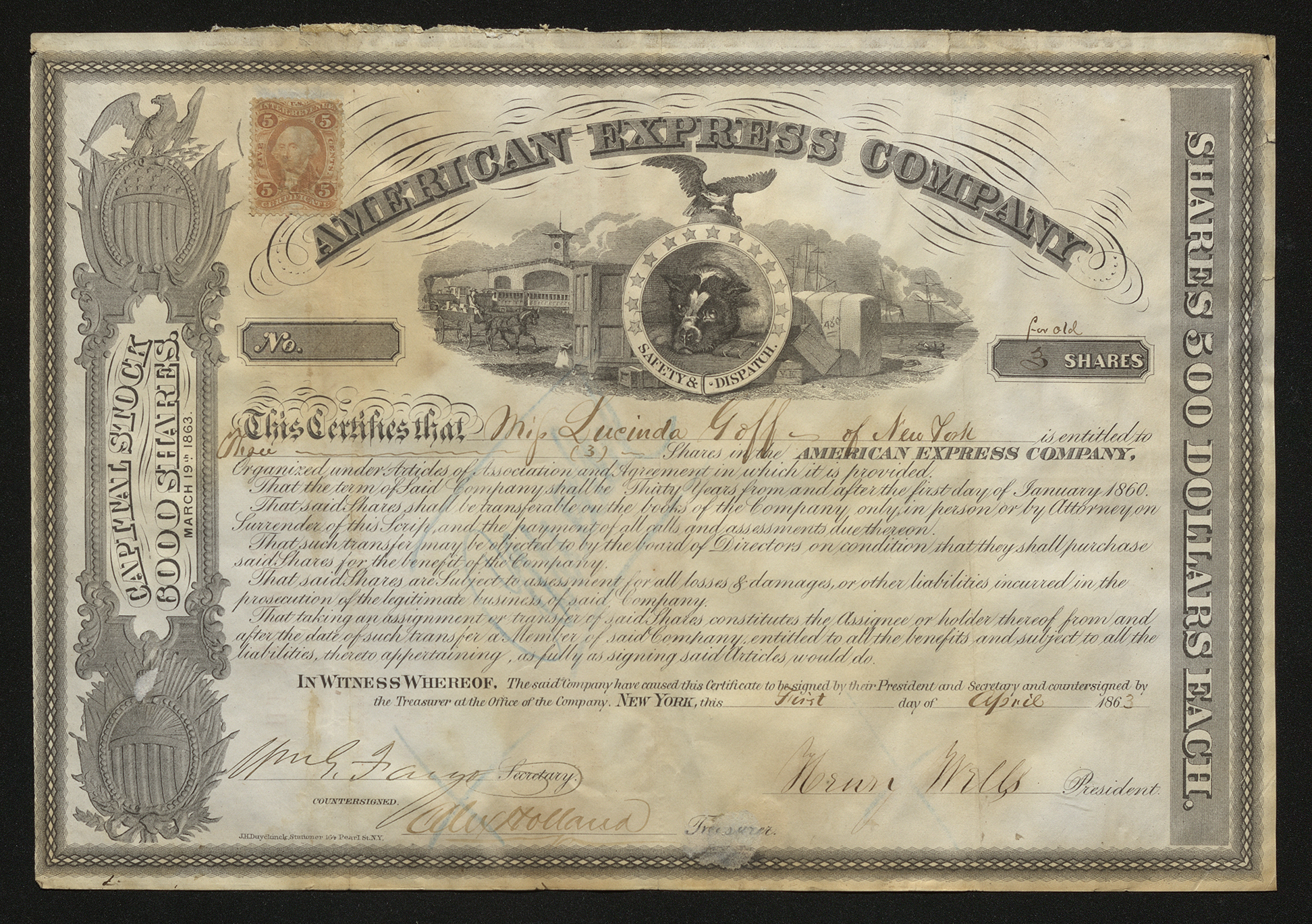
-
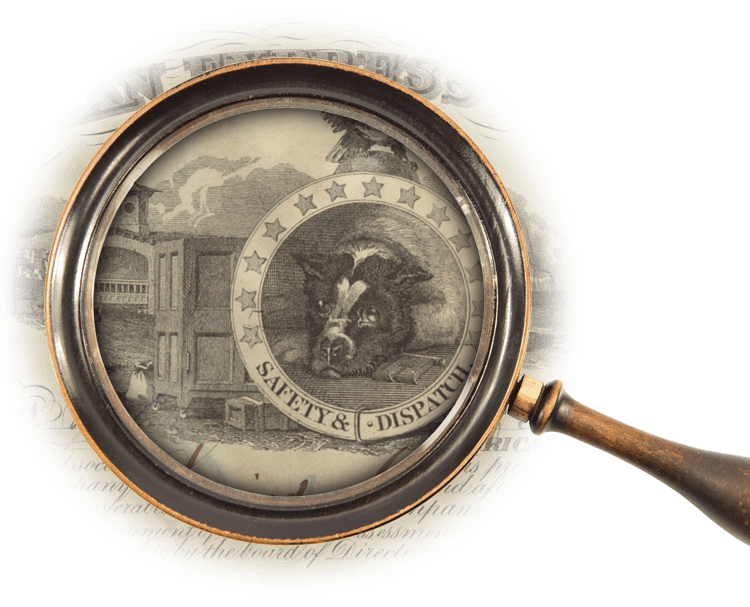 1. The vignette at the top of the certificate shows cargo stacked on the docks of a shipping port with a horse-drawn cart and train depot in the background. The watch dog was the first logo of the American Express Company, used to symbolize the values of trust, security, vigilance, and service.
1. The vignette at the top of the certificate shows cargo stacked on the docks of a shipping port with a horse-drawn cart and train depot in the background. The watch dog was the first logo of the American Express Company, used to symbolize the values of trust, security, vigilance, and service. -
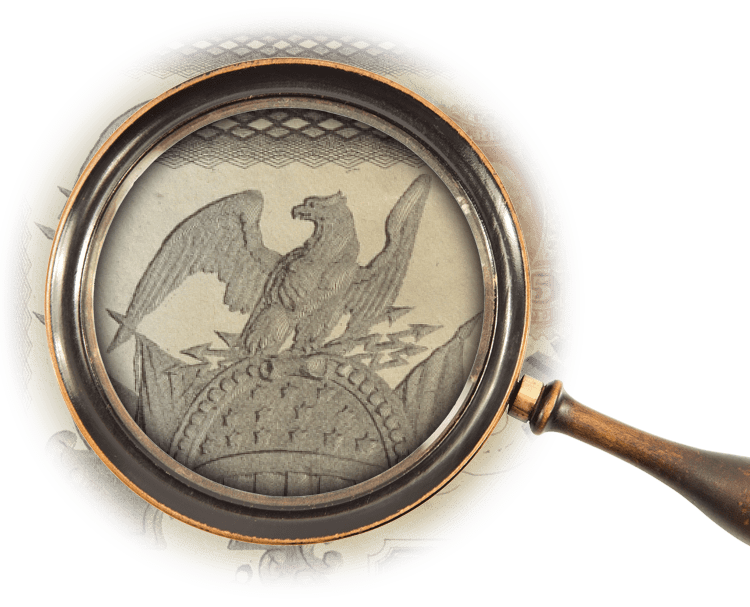 2. On the left, there is classic imagery of the liberty eagle clutching a bundle of arrows, a symbol of war, atop a shield with stars and stripes. Both the shield and the circle around the watch dog feature thirteen stars, an allusion to the original 13 colonies.
2. On the left, there is classic imagery of the liberty eagle clutching a bundle of arrows, a symbol of war, atop a shield with stars and stripes. Both the shield and the circle around the watch dog feature thirteen stars, an allusion to the original 13 colonies. -
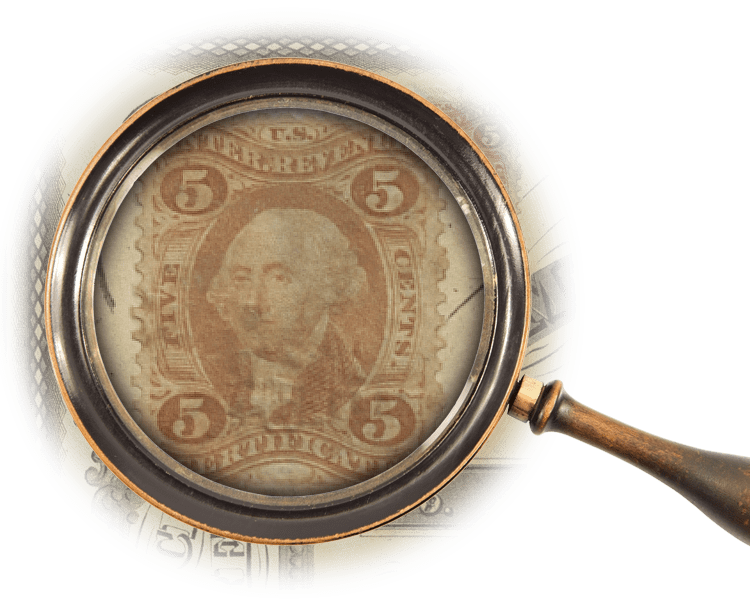 3. This five-cent stamp featuring a portrait of George Washington is referred to as a revenue stamp, used to collect taxes or fees. These stamps were first printed and issued by the U.S. government during the American Civil War and are considered collectibles in themselves.
3. This five-cent stamp featuring a portrait of George Washington is referred to as a revenue stamp, used to collect taxes or fees. These stamps were first printed and issued by the U.S. government during the American Civil War and are considered collectibles in themselves. -
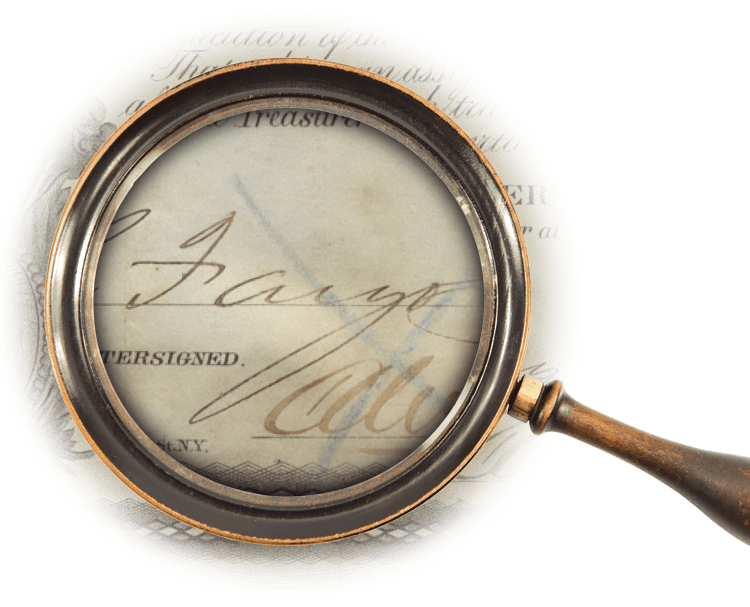 4. This certificate has been endorsed by company secretary William G. Fargo, who founded the company with Henry Wells and John W. Butterfield. The company initially operated in the east, but the California Gold Rush convinced Wells and Fargo to expand operations westward, founding Wells, Fargo & Co.
4. This certificate has been endorsed by company secretary William G. Fargo, who founded the company with Henry Wells and John W. Butterfield. The company initially operated in the east, but the California Gold Rush convinced Wells and Fargo to expand operations westward, founding Wells, Fargo & Co. -
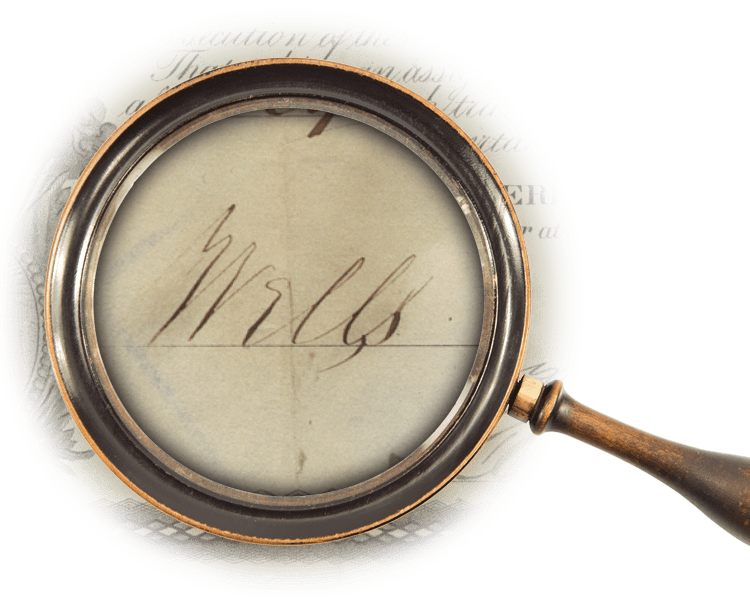 5. This certificate has been endorsed by company president Henry Wells, who founded the company with William G. Fargo and John W. Butterfield. The company initially operated in the east, but the California Gold Rush convinced Wells and Fargo to expand operations westward, founding Wells, Fargo & Co.
5. This certificate has been endorsed by company president Henry Wells, who founded the company with William G. Fargo and John W. Butterfield. The company initially operated in the east, but the California Gold Rush convinced Wells and Fargo to expand operations westward, founding Wells, Fargo & Co. -
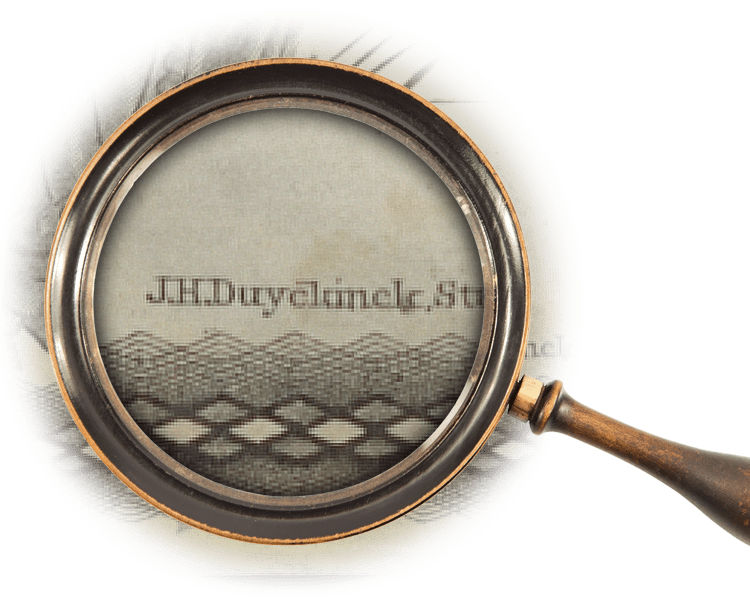 6. Printed by J.H. Duyckinck, Stationer 164 Pearl St. NY
6. Printed by J.H. Duyckinck, Stationer 164 Pearl St. NY
-
-
Bond Imagery Represents Collateral
Featured Bond: 1866—United States of America First Mortgage Bond
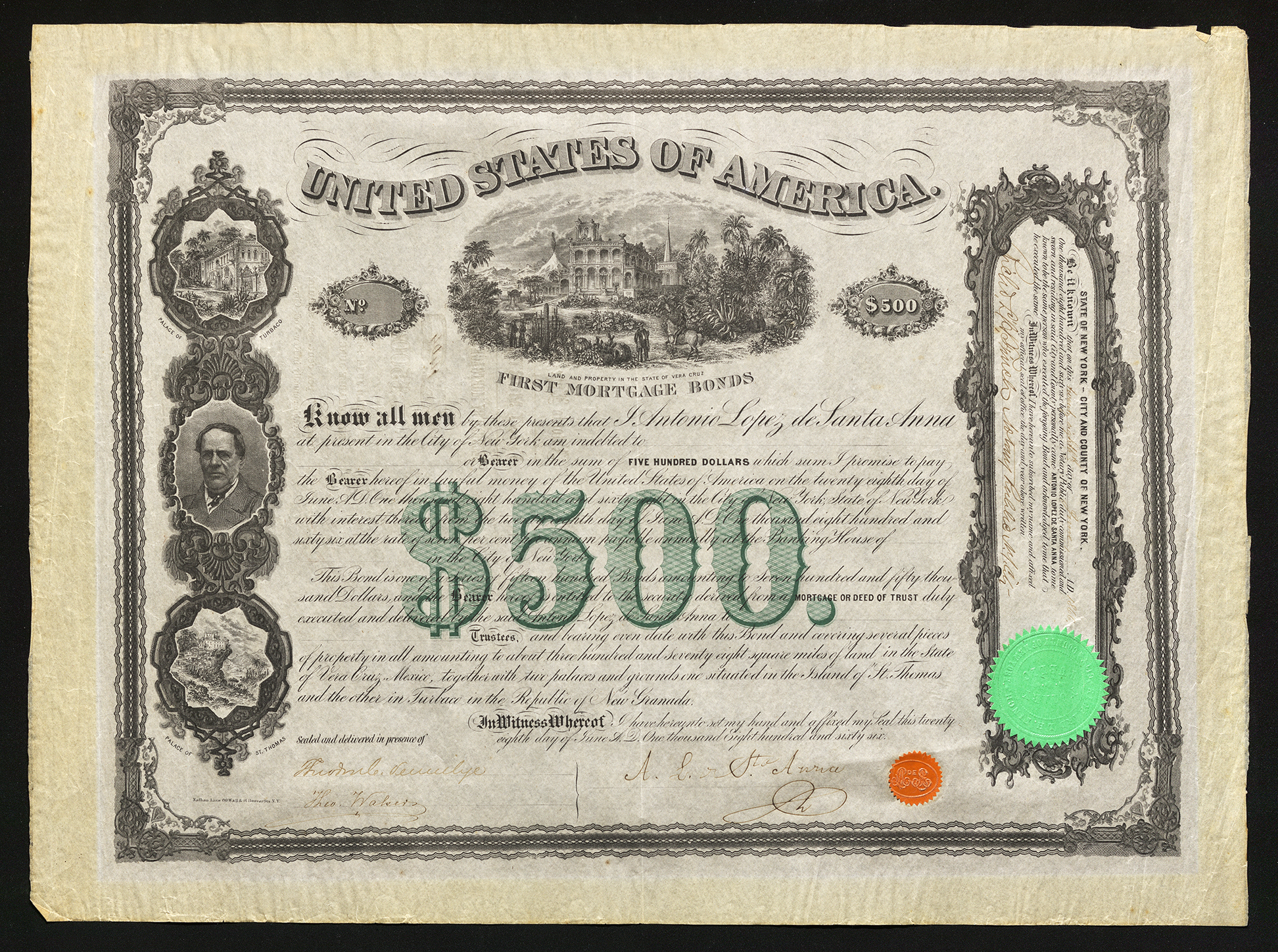
-
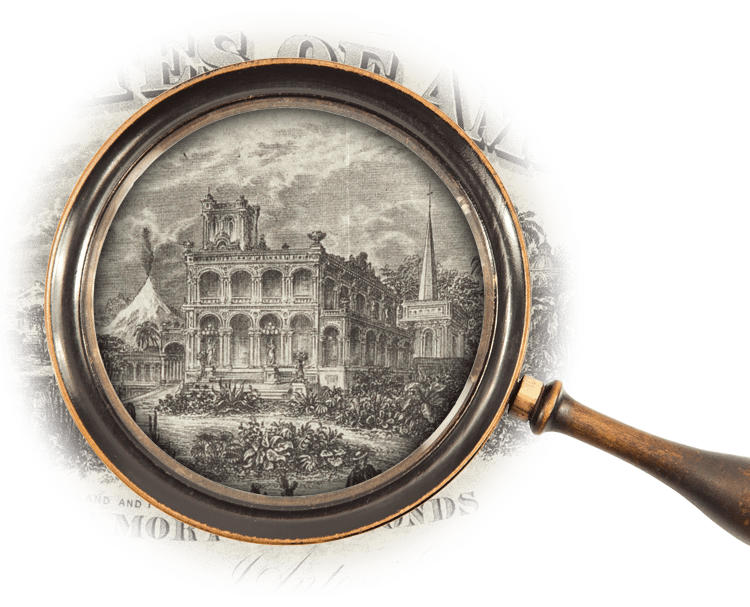 1. This vignette shows Santa Anna’s palace in Vera Cruz. While vignettes generally showed what holders had invested in or allegorical imagery, this bond is unique because it depicts the properties that served as collateral for the bond. This signified that the venture was risky, so these properties were promised to back repayment.
1. This vignette shows Santa Anna’s palace in Vera Cruz. While vignettes generally showed what holders had invested in or allegorical imagery, this bond is unique because it depicts the properties that served as collateral for the bond. This signified that the venture was risky, so these properties were promised to back repayment. -
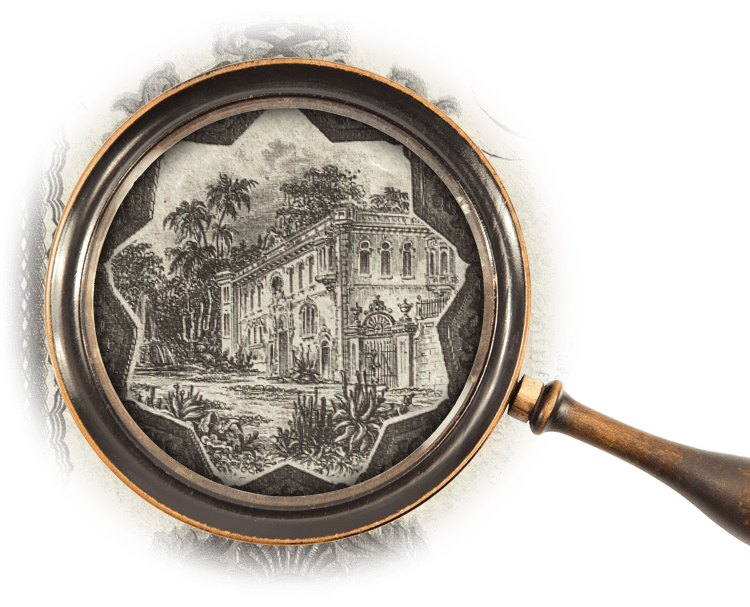 2. This vignette shows Santa Anna’s palace in Turbaco. While vignettes generally showed what holders had invested in or allegorical imagery, this bond is unique because it depicts the properties that served as collateral for the bond. This signified that the venture was risky, so these properties were promised to back repayment.
2. This vignette shows Santa Anna’s palace in Turbaco. While vignettes generally showed what holders had invested in or allegorical imagery, this bond is unique because it depicts the properties that served as collateral for the bond. This signified that the venture was risky, so these properties were promised to back repayment. -
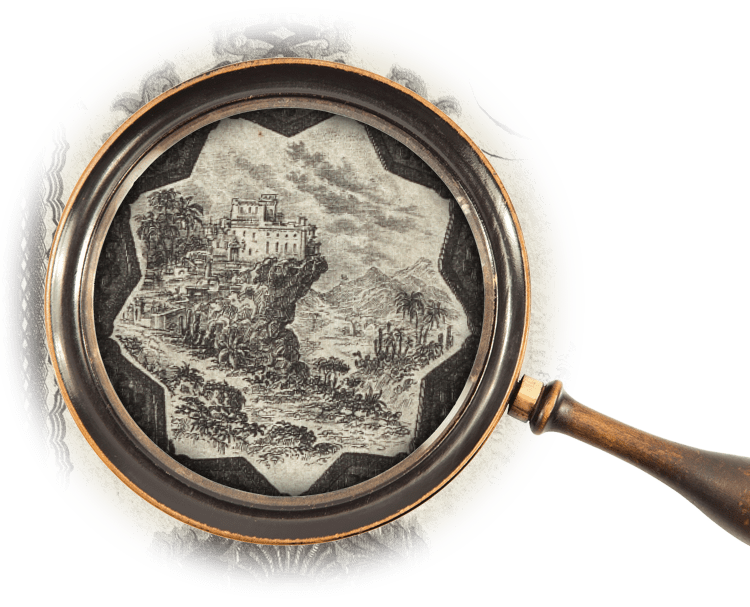 3. This vignette shows Santa Anna’s palace in St. Thomas. While vignettes generally showed what holders had invested in or allegorical imagery, this bond is unique because it depicts the properties that served as collateral for the bond. This signified that the venture was risky, so these properties were promised to back repayment.
3. This vignette shows Santa Anna’s palace in St. Thomas. While vignettes generally showed what holders had invested in or allegorical imagery, this bond is unique because it depicts the properties that served as collateral for the bond. This signified that the venture was risky, so these properties were promised to back repayment. -
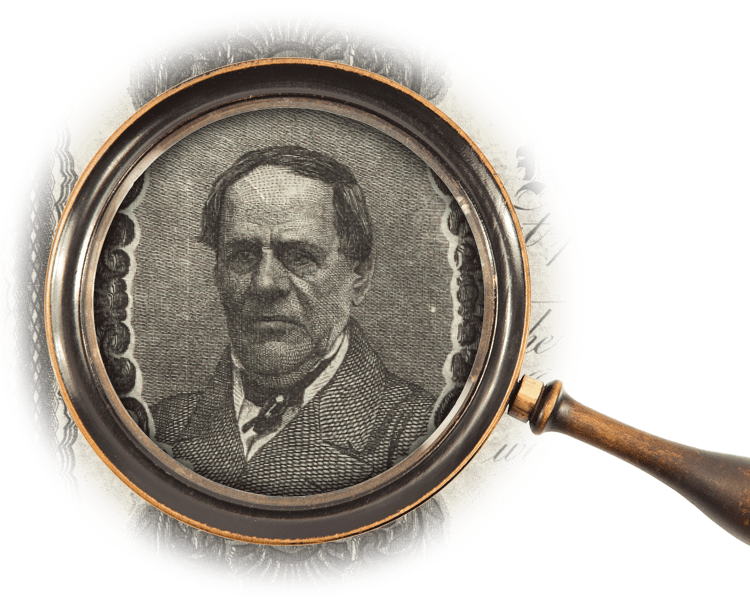 4. A fourth vignette depicts Santa Anna, the Mexican General who led the attack on the Alamo in 1836. Santa Anna was questionable as a leader, also serving as president of Mexico on eleven separate occasions. This mortgage bond was produced to raise funds to support Santa Anna’s return from exile to retake the Mexican presidency.
4. A fourth vignette depicts Santa Anna, the Mexican General who led the attack on the Alamo in 1836. Santa Anna was questionable as a leader, also serving as president of Mexico on eleven separate occasions. This mortgage bond was produced to raise funds to support Santa Anna’s return from exile to retake the Mexican presidency. -
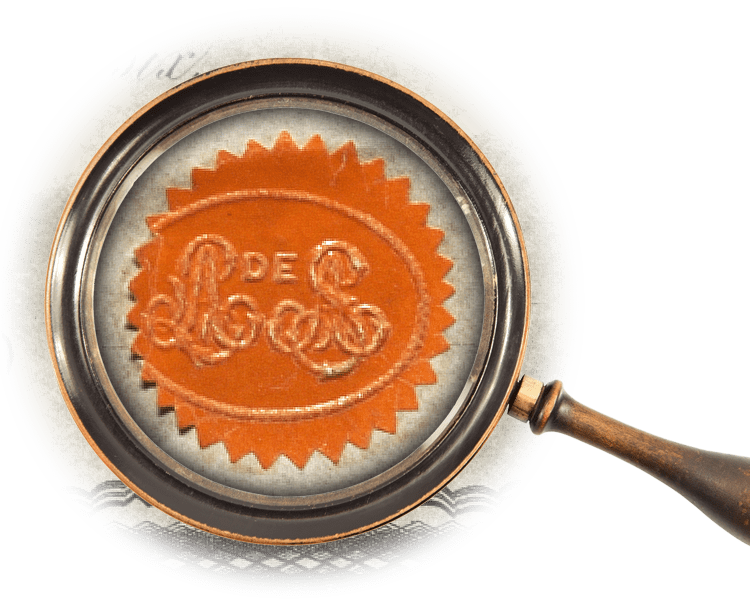 5. This bond also features the signature and seal of Santa Anna, full name Antonio López de Santa Anna. The seal has his initials: AL de SA.
5. This bond also features the signature and seal of Santa Anna, full name Antonio López de Santa Anna. The seal has his initials: AL de SA.
-
-
Imagery Represents a Vision
Featured Bond: 1869—Selma, Marion and Memphis Railroad Company
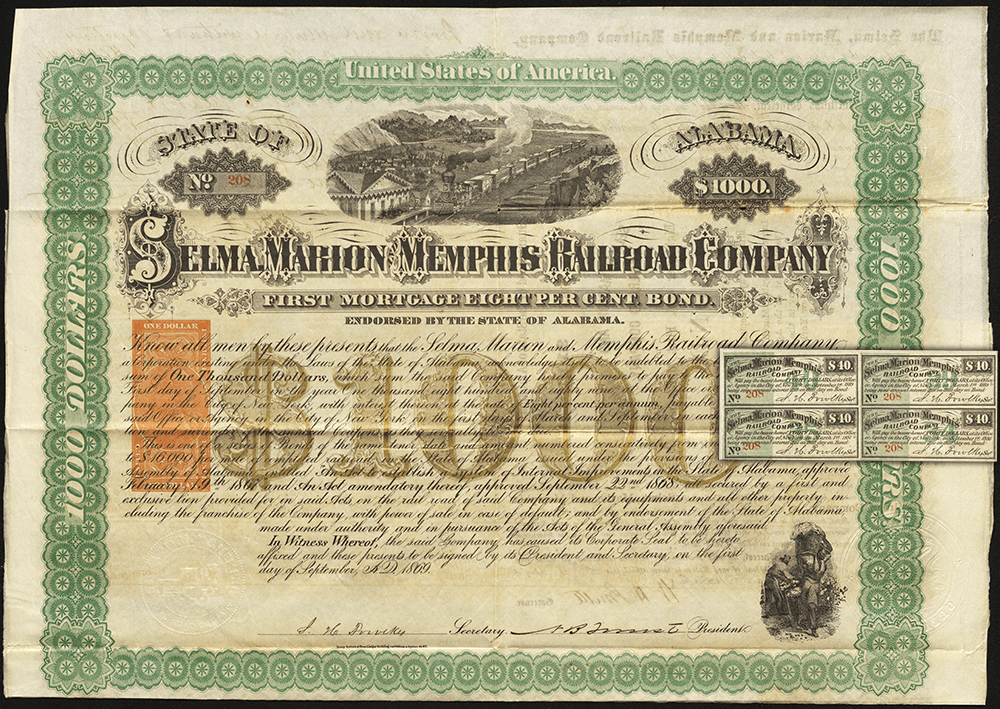
-
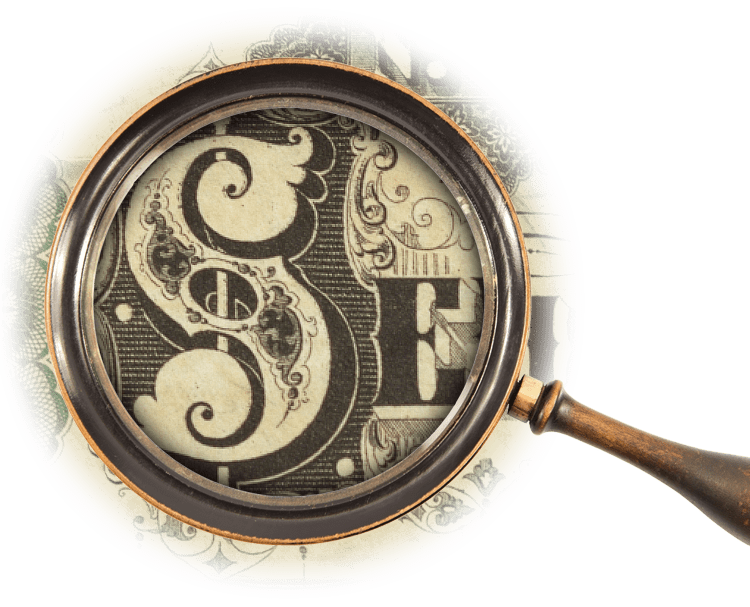 1. This certificate from 1869 shows more complex design elements than many produced over previous decades. The font used for the company title is beautifully illustrated, as is the ‘$1000’ font behind the bond description.
1. This certificate from 1869 shows more complex design elements than many produced over previous decades. The font used for the company title is beautifully illustrated, as is the ‘$1000’ font behind the bond description. -
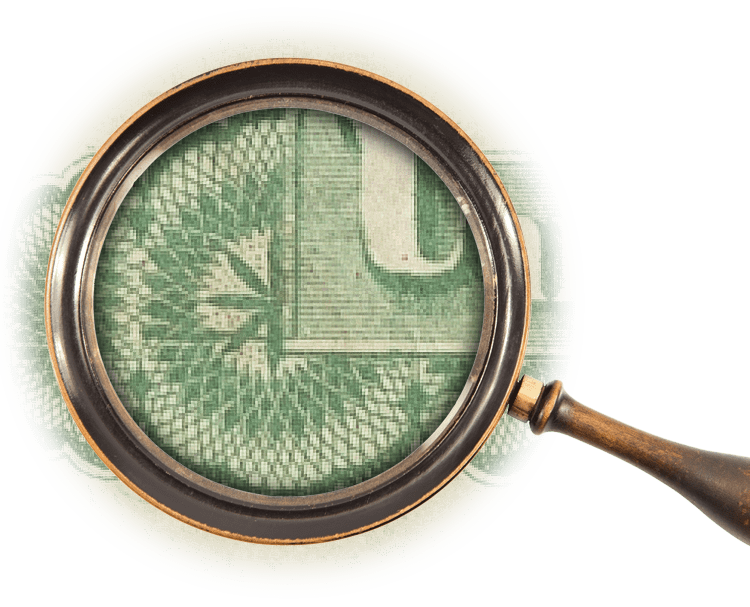 2. The borders show an intricate pattern known as guilloché. This was not merely decorative but a measure against forgery since the fine lines and specific lithographic printing process were nearly impossible to reproduce.
2. The borders show an intricate pattern known as guilloché. This was not merely decorative but a measure against forgery since the fine lines and specific lithographic printing process were nearly impossible to reproduce. -
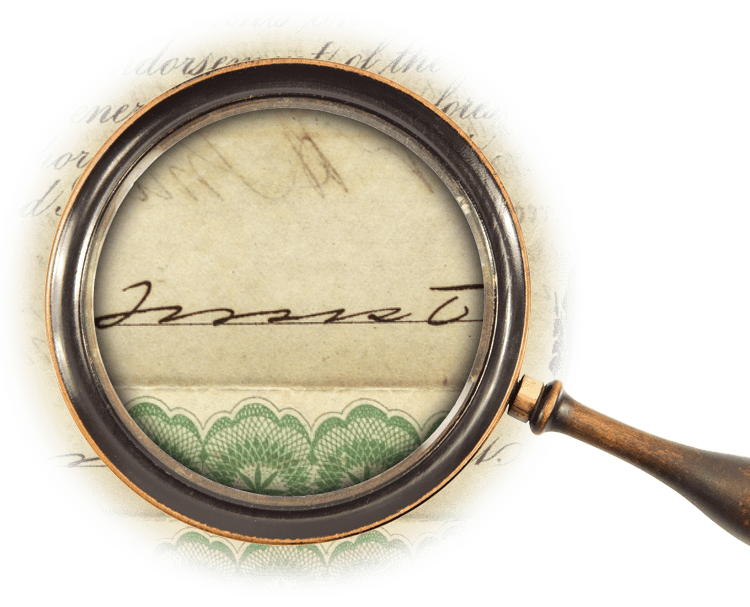 3. This bond was signed by company president Nathan Bedford Forrest who came from poverty but became a wealthy plantation owner. During the American Civil War, he became Lieutenant General in the Confederate Army and led the Fort Pillow Massacre where over 300 Union soldiers—mostly African American—were killed.
3. This bond was signed by company president Nathan Bedford Forrest who came from poverty but became a wealthy plantation owner. During the American Civil War, he became Lieutenant General in the Confederate Army and led the Fort Pillow Massacre where over 300 Union soldiers—mostly African American—were killed. -
 4. A second important signature to note is that of William Hugh Smith, former governor of Alabama (1868-1870). He has endorsed the back of the bond, and the ink can be seen bleeding through to the front here. The government believed it was important to support the growth of the railroad system.
4. A second important signature to note is that of William Hugh Smith, former governor of Alabama (1868-1870). He has endorsed the back of the bond, and the ink can be seen bleeding through to the front here. The government believed it was important to support the growth of the railroad system. -
 5. The two vignettes on this certificate reflect Nathan Bedford Forrest’s vision for a postbellum South. At the top, a train pulls into the depot in a genteel rural community; in the bottom right, African American field hands still pick bushels of cotton.
5. The two vignettes on this certificate reflect Nathan Bedford Forrest’s vision for a postbellum South. At the top, a train pulls into the depot in a genteel rural community; in the bottom right, African American field hands still pick bushels of cotton. -
 6. There is one revenue stamp on the front of this certificate and two on the back. As opposed to earlier examples that have been attached to the document, these ones have been directly imprinted.
6. There is one revenue stamp on the front of this certificate and two on the back. As opposed to earlier examples that have been attached to the document, these ones have been directly imprinted. -
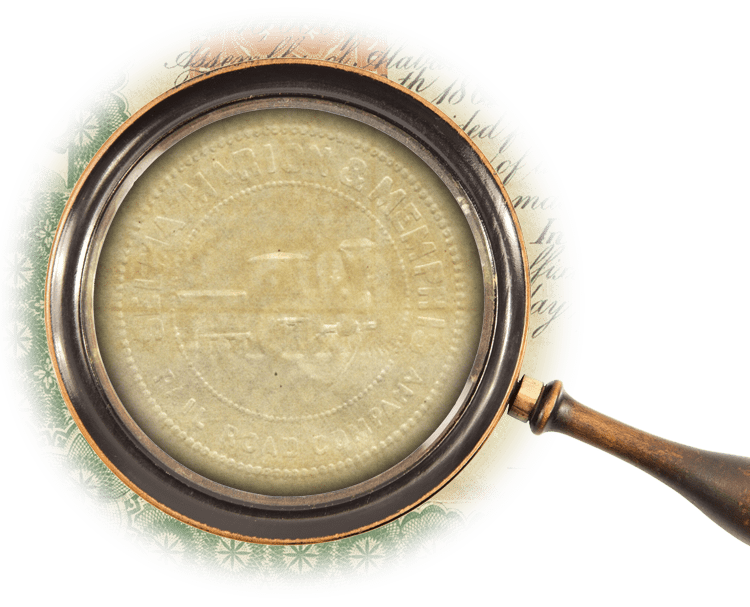 7. There are two embossed marks on this certificate. The one on the left shows a railroad company with a locomotive in the center of the seal.
7. There are two embossed marks on this certificate. The one on the left shows a railroad company with a locomotive in the center of the seal. -
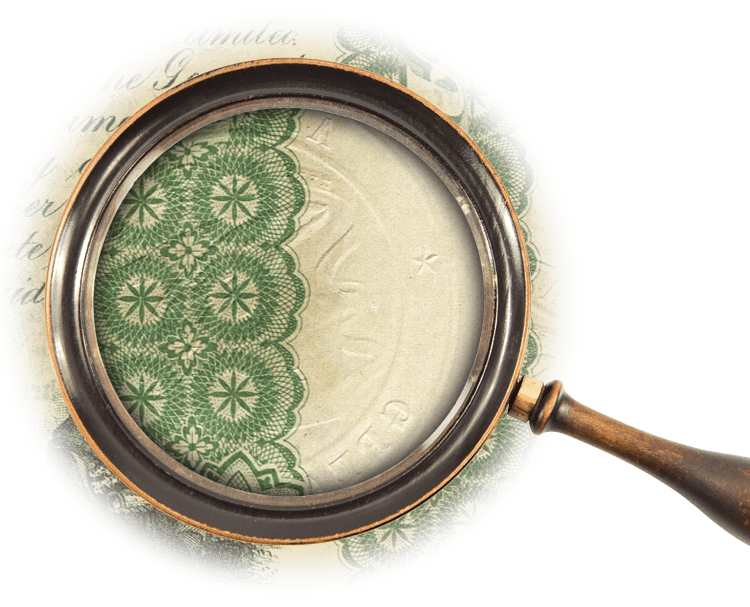 8. There are two embossed marks on this certificate. This one on the right is the Great Seal of the State of Alabama with a liberty eagle in the center, indicating the government’s endorsement of the bond.
8. There are two embossed marks on this certificate. This one on the right is the Great Seal of the State of Alabama with a liberty eagle in the center, indicating the government’s endorsement of the bond. -
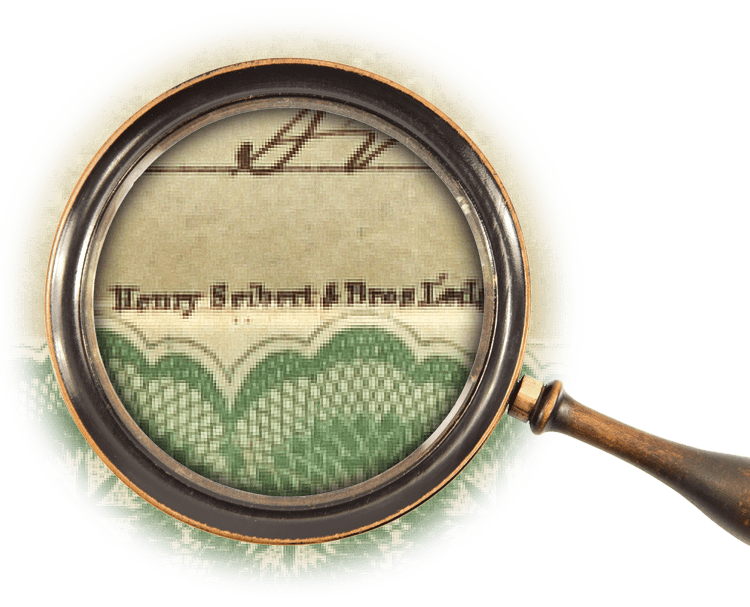 9. This certificate was printed by Henry Seibert & Bros, Lithographers. As designs became more elaborate, the skills of advanced stationers, printers, and lithographing companies were needed in the production process.
9. This certificate was printed by Henry Seibert & Bros, Lithographers. As designs became more elaborate, the skills of advanced stationers, printers, and lithographing companies were needed in the production process. -
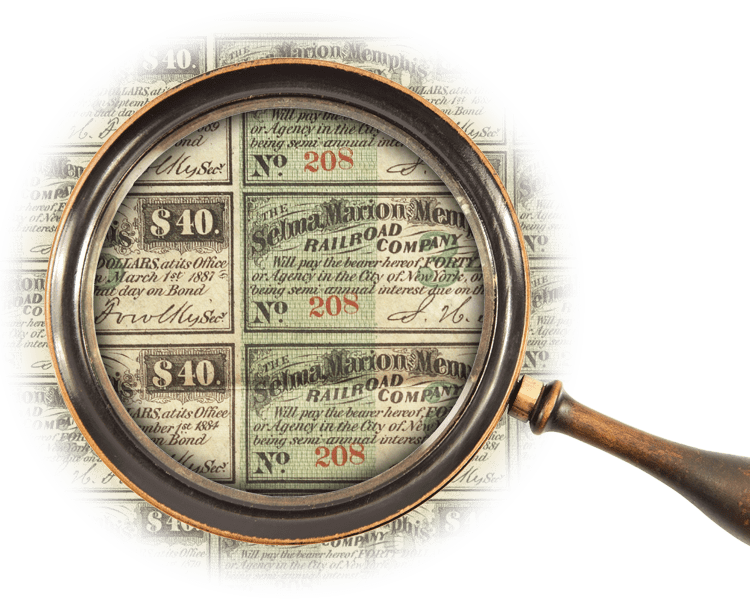 10. Below the main bond are attached forty interest coupons, also referred to as interest warrants. The holder of this bond could claim interest on their investment—in this case $40—at regular intervals. The first seven interest coupons have been redeemed through early 1873, but the rest were never claimed as the company went bankrupt.
10. Below the main bond are attached forty interest coupons, also referred to as interest warrants. The holder of this bond could claim interest on their investment—in this case $40—at regular intervals. The first seven interest coupons have been redeemed through early 1873, but the rest were never claimed as the company went bankrupt.
-
 University of Nevada, Reno
University of Nevada, Reno